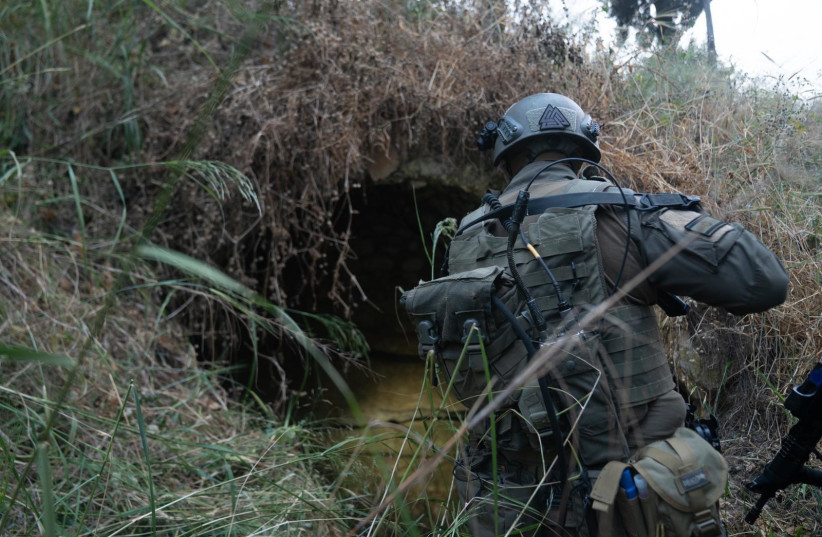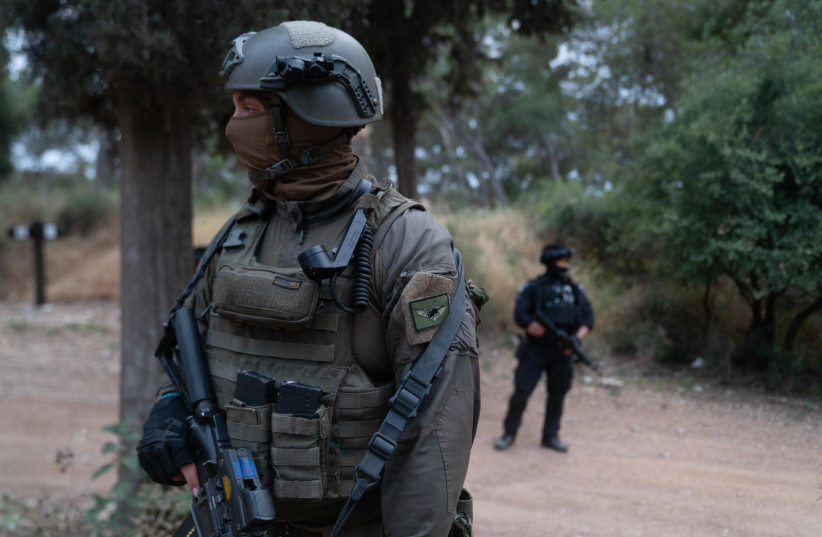With the feeling that time was running out, Israeli security forces worked day and night to find the Palestinian terrorists responsible for the deadly attack in Elad last week.
“It was like looking for a needle in a haystack,” Lt.-Col. Eli Ginsberg, head of the Lotar counter-terrorism unit that took part in the search, told The Jerusalem Post.
On Monday, soldiers, police officers and Shin Bet (Israel Security Agency) agents caught the two suspects – As’sad al-Rifai, 19, and Emad Subhi Abu Shqeir, 20, both from Rummama, near Jenin – in a forested area close to Elad and Nahshonim Park after a manhunt that lasted just over 72 hours.
Ginsberg and his troops arrived in Elad some 30 minutes after the terrorist attack and started to search throughout the city, which still had pedestrians walking and motorists driving.
These were “nerve-wracking hours,” Ginsberg said. “We called up troops who were at home on a Thursday night when they were having barbecues, but they didn’t ask any questions about it.”
“We are on constant alert, and when we heard of the attack, we rushed to the scene and started working with police to search the area,” he said. “Then we realized that they had fled the scene, and we had to expand our search area.”
Some 800 soldiers took part in the manhunt, including forces from the IDF’s Commando Brigade (Egoz, Maglan and Duvdevan units), Ginsberg’s Lotar counter-terrorism unit, the Ghost unit and the Mirol tracking unit.
Security forces searched a radius of six to nine kilometers from Elad, including a closed firing zone close to the city, and Rosh Ha’ayin, which Ginsberg is familiar with because it is under his base’s responsibility.
The Mitkan Adam army base, where the Lotar counter-terror school is located, is divided into different sections according to specialization, including high-altitude rappelling, sniping, robotics, climbing and rescue.
“I know the area very well – we train there,” Ginsberg said. Nevertheless, “it felt like an hourglass with time running out as we searched. We did not know if there would be another attack. The intelligence assessment was that they were still in the area and had not crossed back. So we constantly continued to scan using all means.”
“We searched with everything we had – from troops on the ground who are turning over every rock, to cars, drones, planes and helicopters,” he said. “There are a lot of caves and tunnels in the area and a big quarry north of Elad, and troops went to search those areas.”
Soldiers also searched the streams in the areas that lead back to the West Bank, about three to four km. from Elad. Once a suspect enters the stream, it is very hard to find them, Ginsberg said.
During the search, troops found bloody banknotes and pieces of pita, as well as traces of blood in a certain area. They also searched for broken branches that could lead them to the fleeing suspects.
“We found so many things during the search, and we had to differentiate between what was relevant and what wasn’t,” Ginsberg said, adding that they also had to triage calls that they received from civilians who thought they had seen the suspects.
Civilians also attempted to help troops.
One night they had to rush toward a figure that had been identified by observation equipment in the search area, Ginsberg told the Post.
“Time continued to tick on, and we didn’t find them, and it is very easy to start speculating that they weren’t there anymore,” he said. “The distance between Elad and the closest part of the fence is a 30-minute walk.”
As the search dragged on with no intelligence on where the suspects were, “the most important thing was not to give up: to continue to work systematically, and in the end we got them,” Ginsberg said.
When the bloodstained money was found on Saturday, it was the last hint that the terrorists were in the area. Confirmation came at 2 a.m. with the results of a DNA test.
“We worked during the day and at night,” he said. “We were ready for any movement in the area.”
Ginsberg, who also took part in the search for the prisoners who escaped from Gilboa Prison in September as well as the recent attack on Dizengoff Street in Tel Aviv, said the troops integrated the lessons learned during those manhunts.
“We looked for two weeks for the Gilboa prisoners, and we were in the same situation,” he said. “It felt as though time was running out, and we were searching a huge area. And while it was a very different scenario, we didn’t know where they could be, so we looked at everything that could have pointed us toward them.”
On an operational level, the cooperation between IDF forces and the police was “amazing. There was zero ego,” Ginsberg said, adding that police systematically divided the search areas and used the forces properly.
“One of the main lessons from the attack on Dizengoff was order, command and isolation of areas,” he said. “These are basic things that happened relatively well... all the units involved in the search brought their own capabilities and added another level to the manhunt.”
And while Ginsberg was in another polygon when the two suspects were found, he was proud of his forces who “gave up sleep and food” to bring back a sense of security to the residents of Elad.
“What drives us are the civilians, and when you see such a horrible scene, this is why we are here,” he said.


